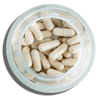Solid Lipid Nanoparticles (SLNs) are tiny carriers (10–1,000 nm) designed to protect and improve the absorption of compounds, especially those with poor water solubility. They are particularly useful for delivering longevity supplements like NMN, Resveratrol, Fisetin, and Spermidine, which often degrade in digestion or struggle with low absorption.
Key Benefits of SLNs:
- Protect Compounds: Shields sensitive supplements from stomach acid and enzymes.
- Enhance Absorption: Improves uptake in the intestines using small size and surface modifications.
- Bypass Liver Breakdown: Avoids first-pass metabolism by promoting lymphatic uptake.
Why It Matters:
Longevity supplements aim to combat aging-related declines, like reduced NAD⁺ levels. However, their effectiveness depends on how well they’re absorbed. SLNs solve this by boosting bioavailability, ensuring more of the active ingredient reaches your bloodstream.
Example: Resveratrol-loaded SLNs doubled bioavailability in studies compared to standard forms.
SLNs are reshaping supplement delivery, making longevity compounds more effective and accessible.
Solid Lipid Nanoparticles: Preparation, Characterization and Applications- A Look Back
How SLNs Improve Bioavailability
Solid Lipid Nanoparticles (SLNs) enhance the oral absorption of longevity compounds through three primary mechanisms.
Protection Against Digestive Breakdown
The gastrointestinal tract is a challenging environment where stomach acid, digestive enzymes, and other processes can break down sensitive compounds before they’re absorbed. SLNs act as a protective barrier, encapsulating these compounds within a solid lipid matrix that shields them from degradation in the gut [1][2]. Since SLNs are composed of lipids that remain solid at both room and body temperatures, they maintain their protective structure throughout digestion [2]. For instance, research by Pandita et al. showed that resveratrol-loaded SLNs, created using the solvent diffusion method, effectively protected resveratrol from photodegradation [2]. This ability to safeguard compounds ensures their integrity as they navigate the harsh digestive system.
Better Intestinal Absorption
Once protected in the gut, SLNs aid in efficient absorption across the intestinal barrier. With about 90% of drug absorption occurring in the small intestine [4], SLNs facilitate this process through both transcellular and paracellular pathways [1]. Their small size (20–500 nanometers) increases their interaction surface with epithelial cells, promoting better uptake [3][1]. Additionally, surface charge is a key factor: negatively charged SLNs often show higher lymphatic uptake [3], while positively charged ones enhance transport through mechanisms like caveolae-mediated endocytosis, M cell phagocytosis, and reversible tight junction opening [6]. A study on PEGylated SLNs revealed improved absorption efficiency and extended blood circulation, achieving nearly double the relative bioavailability (1.99-fold) in rats compared to standard SLNs [5]. The PEGylation also allows them to penetrate mucus barriers more effectively, further boosting absorption [5].
Bypassing First-Pass Metabolism
In addition to protecting compounds and improving absorption, SLNs enhance systemic delivery by avoiding early metabolic breakdown. They bypass first-pass metabolism by promoting selective lymphatic uptake [1]. After being absorbed in the intestines, SLNs are incorporated into chylomicrons by enterocytes, enabling their transport through intestinal lymphatic vessels [3]. SLNs can also be absorbed via lymphoid tissues, such as Peyer’s patches, which allow compounds to enter the bloodstream without initial exposure to liver metabolism [8]. For example, Bhalekar et al. (2016) developed Darunavir SLNs using glyceryl monostearate, glyceryl caprylate, Span 80, and Tween 80. In vivo studies with Wistar rats showed significant lymphatic absorption and improved bioavailability compared to standard tablets [7].
Together, these mechanisms - protection against digestive breakdown, enhanced intestinal absorption, and bypassing first-pass metabolism - highlight the potential of SLN technology to improve the effectiveness of longevity supplements.
SLN Studies with Longevity Compounds
Recent research highlights how solid lipid nanoparticles (SLNs) enhance oral bioavailability and protect longevity compounds during digestion.
NMN and NAD+ Precursors
SLNs have shown significant promise in improving the delivery of NMN and other NAD⁺ precursors. In 2023, Zhang et al. developed a hydroxyapatite (HAP)-based nano-drug delivery system to boost NMN bioavailability. Their NMN-HAP nanoparticles, which were rod-shaped and roughly 50 nanometers in size, achieved an encapsulation rate of over 40% and improved NMN's circulation time and bioavailability. This led to elevated plasma levels of NMN, NAD⁺, and nicotinamide riboside (NR) compared to free NMN formulations[10].
Vakilinezhad et al. (2018) explored nicotinamide (NAM)-loaded functionalized SLNs in an Alzheimer's disease animal model. Their results demonstrated enhanced cognitive performance by reducing Tau hyperphosphorylation[11]. Additionally, coupling NMN with an ANG peptide has shown potential, as ANG-NMN-lips achieved a Papp value of 10⁻⁵, indicating efficient transport[9].
These findings highlight the effectiveness of SLNs in delivering NAD⁺ precursors, paving the way for their application in polyphenol delivery.
Resveratrol and Fisetin
Polyphenols like resveratrol and fisetin often face challenges such as poor water solubility and rapid metabolism, which limit their bioavailability. For example, fisetin has a bioavailability of just 44.1%, a solubility of 10.45 μg/mL, and a logP of 3.2[12]. SLN technology offers a solution to these limitations.
In a 2018 study, resveratrol-loaded SLNs with an average particle size of 241 nanometers demonstrated approximately double the bioavailability in the brain, kidney, and liver compared to free resveratrol[13]. Similarly, SLNs enhanced fisetin's bioavailability and enabled its controlled, sustained release[14]. By protecting these labile molecules and utilizing physiological lipids, SLNs also address potential toxicity concerns[12].
Spermidine Stabilization
Efforts to improve spermidine delivery have focused on enhancing targeted cellular uptake. Jing Tang et al. (2017) found that spermidine-modified PLGA nanoparticles (~172.5 nanometers) doubled A549 cell uptake and improved lung targeting by 3.62- to 4.66-fold compared to standard PLGA nanoparticles and free drug[15]. These advancements leverage the polyamine-transport system (PTS), which naturally facilitates the uptake of polyamines like spermidine[15].
Together, these studies demonstrate that SLN-based strategies consistently overcome the challenges of oral delivery for longevity compounds. At MASI Longevity Science, we integrate these scientific advancements into our supplements, ensuring optimal absorption and effectiveness for products like NMN, Resveratrol, Fisetin, and Spermidine.
sbb-itb-4f17e23
Recent SLN Technology Developments (2023–2025)
Recent strides in Solid Lipid Nanoparticle (SLN) design are reshaping how longevity compounds are delivered to their cellular targets. By refining manufacturing techniques and improving surface engineering, researchers are unlocking new ways to enhance the effectiveness of compounds like NMN and resveratrol.
Core–Shell Structures
Microfluidic technology has become a game-changer for producing core–shell nanoparticles, offering precise control over particle size, composition, and structure. This precision is vital for improving the bioavailability of sensitive compounds. For instance, Lian and colleagues developed a needle-based microfluidic platform capable of producing nanoparticles at a rate of 160 per minute with a coefficient of variation below 3%. When this system was scaled up using parallelized platforms, production rates reached 660 and 1,300 droplets per minute, all while maintaining the same high level of precision [16].
Core–shell structures are particularly effective because their design includes a hydrophobic core, which protects delicate molecules from being broken down during digestion, and a hydrophilic corona, which boosts intestinal absorption. These features make them ideal for delivering longevity compounds with greater efficiency [16].
Surface Modifications
Advances in surface engineering are also addressing critical challenges in oral delivery, such as stability and targeted delivery. Techniques like PEGylation - coating SLNs with polyethylene glycol - have been shown to enhance intestinal penetration and extend circulation time, effectively doubling bioavailability [17].
Chitosan coatings provide another layer of improvement, as they enhance stability in acidic environments, allow for longer storage periods, and improve cellular permeability [17].
Additionally, the use of functional lipids, such as cholesterol and phytosterols, has shown promise in increasing membrane stability, enhancing permeability through the blood-brain barrier, and facilitating endosomal escape. These features are crucial for ensuring longevity compounds reach their intended cellular destinations effectively [17].
At MASI Longevity Science, we integrate these advanced SLN technologies into our formulations, ensuring compounds like NMN, resveratrol, fisetin, and spermidine achieve maximum bioavailability and therapeutic impact. These innovations are paving the way for more effective longevity supplements.
The Future of SLNs in Longevity Science
Advances in nanotechnology and longevity research are paving the way for more effective anti-aging solutions. With the rapid growth of the market, solid lipid nanoparticles (SLNs) are emerging as key players in the transformation of how longevity compounds are delivered and utilized. These trends highlight the increasing demand for advanced delivery systems in this field.
Recent studies showcase the potential of SLN technology. On January 7, 2025, researchers reported a 4.3-fold increase in bioavailability using ritonavir-loaded SLNs compared to traditional formulations. The formulation achieved a particle size of 265.06 nm, an encapsulation efficiency of 86.2%, and a cumulative release rate of 94.8% [18]. This demonstrates how SLNs can transform compounds with low bioavailability into highly effective therapeutic agents.
Building on these advancements, new designs are being developed to further enhance targeting and cellular uptake. SLNs are especially effective in improving the oral delivery of longevity compounds. Future innovations are expected to focus on precise targeting and improved cellular absorption. For instance, researchers are working on patchy nanoparticles with clustered ligands to achieve better cellular uptake and more accurate in vivo targeting [19].
SLNs are biocompatible, biodegradable, and designed for controlled release, making them an excellent choice for long-term supplementation. Their ability to protect sensitive compounds during storage and transport, while enhancing intestinal absorption, ensures that users gain the maximum benefit from these advanced formulations.
The evolution of SLN technology builds on its proven advantages in protecting compounds, improving absorption, and bypassing metabolic barriers. At MASI Longevity Science, we are dedicated to incorporating cutting-edge SLN research into our formulations of NMN, resveratrol, fisetin, and spermidine. By doing so, we provide our community with supplements that offer enhanced bioavailability and greater cellular impact. With a commitment to scientific progress, rigorous German manufacturing standards, and independent Swiss testing, we are proud to lead the way in the longevity revolution.
FAQs
How do Solid Lipid Nanoparticles (SLNs) improve the absorption and effectiveness of longevity supplements like NMN and Resveratrol?
Solid Lipid Nanoparticles (SLNs) are transforming the way longevity supplements like NMN and Resveratrol are absorbed and utilized by the body. These nanoparticles tackle two major hurdles: poor solubility and ingredient degradation.
By using a lipid-based matrix, SLNs help dissolve compounds that don’t mix well with water, making them much easier for the body to absorb. On top of that, they act as a protective shield, preventing active ingredients from breaking down before they can reach the bloodstream.
What’s more, SLNs improve how well nutrients pass through the intestinal lining, allowing for more efficient absorption into the body’s circulation. Together, these advantages - better solubility, protection, and absorption - position SLNs as a game-changing approach to boosting the effectiveness of longevity supplements.
What makes solid lipid nanoparticles (SLNs) a better option for improving the absorption of supplements with poor water solubility?
Solid lipid nanoparticles (SLNs) are making waves as a modern approach to improving how supplements with low water solubility are absorbed by the body. These nanoparticles use a lipid-based structure to shield active ingredients from breaking down in the digestive system, allowing for better absorption. This means more of the supplement’s benefits actually make it into your system - especially helpful for compounds that don’t dissolve easily in water.
What’s more, SLNs offer controlled release and targeted delivery of these active ingredients. This ensures a steady, efficient supply of nutrients while minimizing potential side effects. By delivering supplements in this precise way, SLNs provide a smarter, more dependable method to support your health.
Can solid lipid nanoparticles (SLNs) enhance the effectiveness of supplements for cognitive health or other wellness benefits beyond aging?
Solid lipid nanoparticles (SLNs) are emerging as a promising tool for enhancing the effectiveness of supplements, particularly in supporting brain health and cognitive performance. These nanoparticles work by improving the delivery of active compounds to the brain, which can play a role in reducing oxidative stress and positively influencing behavioral outcomes, as seen in preclinical studies.
One of the standout features of SLNs is their ability to increase the bioavailability of various bioactive compounds. This makes them a powerful option for addressing challenges like neurological conditions. Beyond aging, SLNs open up possibilities for supplements aimed at promoting mental clarity, focus, and overall vitality.




